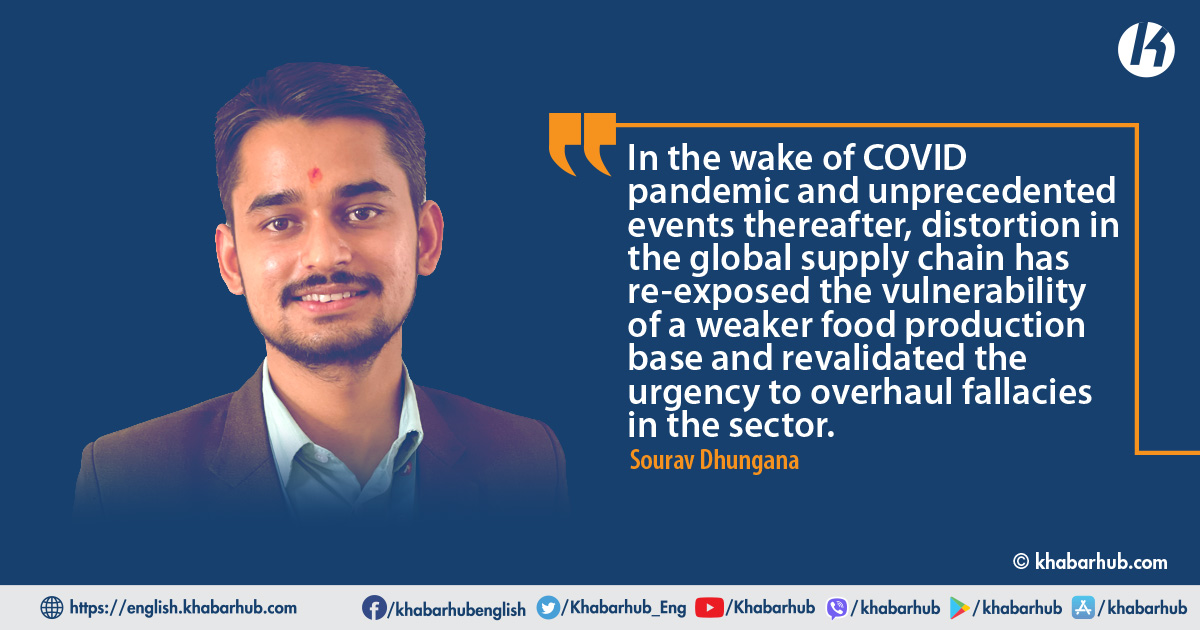Nepal’s agriculture sector contribution to the economy has dwindled by around 7 % over a decade leading to 24.90 % in FY 2020/21, according to the Central Bureau of Statistics.
It comes as no surprise when around 68 percent of farmers, among the two-thirds agriculture-dependent population, are pursuing subsistence farming.
Some studies further indicate that about 60 percent of the farmers are themselves unable to meet their own food needs, let alone focus on the commercialization of the farm sector.
The Finance Ministry’s Economic Survey 2021/22 states Nepal’s food import figure reached around USD 2.4 billion in 2021 and is bound to increase further.
These depressing figures are a vivid reflection of Nepal’s failure in agriculture development. In such circumstances, policy stakeholders are wary if it can ever rise beyond the subsistence level. However, agriculture, despite poor performance, remains a major source of livelihood and thus, strongly justifies the need to revamp our approach to overcoming impediments to agriculture development.
In Nepal, people’s participation in agriculture remains highly imbalanced in comparison to its contribution to the national economy.
With food imports increasing on a year-on-year basis, the serious question is: can Nepal still afford to overlook the upcoming crisis on food security?
Despite lower productivity, inter-generational transfer of land ownership continued with traditional farming practices dominating various spheres of life in Nepal.
The land is still the most reliable asset for financial security and discussions for the transition of the workforce towards non-farm sectors pays little attention to this fact.
Furthermore, the transition from an agriculture-based economy requires people to abandon their jobs and re-orient themselves by grabbing opportunities in non-farming sectors.
The risks are high that farmers struggle in integrating themselves on new terms and rather prefer to opt-out. And the likelihood is high for rural farmers especially when they have small landholding, are old aged, and lack support to capacitate themselves in non-farm jobs.
Similarly, another aspect concerned with the transition to the non-agriculture sector is the market’s ability to absorb such a workforce at entry-level positions.
However, Nepal failed to do so owing to its poor industry and service sector growth. This has led to a surge in foreign labor migration among unskilled and semi-skilled youth to gulf countries.
Despite an increased remittance inflow, its long-term consequences are detrimental to abandoned farms, increased food import, and setbacks to possibilities for agro-development.
Another critical factor is the increasing demand for food grains and their level of production inside the country which must be considered through the lens of food security and the national economy.
A study conducted by Kumar et. al in 2019 predicts a 26 % increase in demand for rice, wheat and maize by 2035.
A study carried out by Ananta Dahal in 2013 states that irrigation projects in Nepal accounted 75 % increase in farmers’ annual income after access to year-round irrigation.
Meanwhile, the government forecast estimates rice production to increase by only 14.99 % in 2043 from the 2014/15 level while wheat and maize yield is expected to increase by 14.38 % and 7 % respectively.
With food imports increasing on a year-on-year basis, the serious question is: can Nepal still afford to overlook the upcoming crisis on food security?
If so, Nepal is running out of time to implement pragmatic policies for improving prerequisites for agriculture development until it’s too late to match up the production-demand gap.
Over the years, transforming Nepal into an agriculturally self-reliant nation has largely been limited to political rhetoric.
Meanwhile, insufficient government intervention and ineffective plans and programs have done little to achieve this. Had the government been able to provide irrigation facilities throughout the year, supply chemical fertilizers on time and ensure the supply of improved seed varieties, Nepal would have witnessed an increase in the production of food staples.
This has already been proven by a study conducted by Thapa, Y.B and Pokhrel, A. in 2003 concerning factors that affect the adoption of improved agricultural practices in Nepal.
The study concluded that the contribution of variety (improved seed), irrigation and their interaction both was 30%, 29%, and 41% respectively for the increase in production.
Keeping the fiasco of chemical fertilizer aside, building irrigation canals in a water-abundant country seems more to be a matter of political will rather than technical know-how.
As of 2018/19, only 33 % of total irrigable land in Nepal has access to year-round irrigation facilities and the government’s efforts seem insufficient to meet the coverage target of 50 % by FY 2022/23.
Regarding improved seeds, an increase in Research & Development has succeeded in developing improved varieties of seeds on both the national and global scale.
At the end of the day, there are empty stomachs to feed, therefore, farmers and farms will always remain as important as they were ever before.
However, the matter of accessibility and affordability has always been a pressing issue where farmers often end up cultivating poor quality low-yielding varieties.
Such basic infrastructure can enable farmers to carry out year-round farming, reduce their production costs and boost production capacity.
A study carried out by Ananta Dahal in 2013 states that irrigation projects in Nepal accounted 75 % increase in farmers’ annual income after access to year-round irrigation.
Such an increase in disposable income can play a pivotal role to retain existing farmers and attract others to adopt scientific farming.
In the wake of the COVID pandemic and unprecedented events thereafter, the distortion in the global supply chain has re-exposed the vulnerability of a weaker food production base and revalidated the urgency to overhaul fallacies in the sector.
The reasons even become stronger when such events exposed how fragile working-class lives are from falling below the poverty line.
Nepal lies at a critical juncture to implement policies that foster a conducive agro-ecosystem where farmers with access to basic infrastructure can produce more, sell goods at the internal market, and get reasonable product prices.
For now, taking practical steps to develop basic infrastructure can retain farmers in the sector with increased income and improved lives.
At the end of the day, there are empty stomachs to feed, therefore, farmers and farms will always remain as important as they were ever before.
(The writer is a Master’s candidate at Willy Brandt School of Public Policy, Germany)









Comment